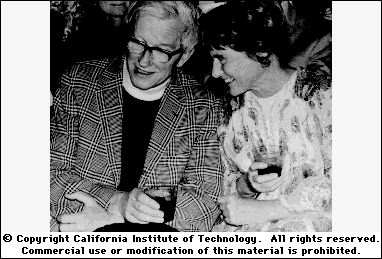

Delbruck's early interest was in astronomy, but according to his biographers he realized that German astronomy was at a
dead end in the 1920s and switched to quantum mechanics. He interacted with many of the great German physicists of the
day, including Pauli, Einstein, and others. His advisor was Max Born. In the summer of 1931 Delbruck went to
Copenhagen to work with Niels Bohr. A later colleague in the "RNA Tie Club," George Gamow, was also there. Delbruck
returned often to Copenhagen and the open, critical, scholarly atmosphere Bohr created among his group was a major
influence on Delbruck's own style of science. Delbruck then had a Rockefeller Fellowship that took him to Bristol,
England. In 1932 he returned to Berlin to work with Lise Meitner. The situation in Germany became intolerable, however,
and in 1937 he obtained a second Rockefeller Fellowship and used it to move to Caltech. Shortly after Delbruck left,
Meitner discovered nuclear fission. Delbruck said his waning interest in physics was by then holding back Meitner's group
and took indirect credit for allowing the discovery by removing himself from Meitner's lab!
Delbruck's interest in biology is usually dated to his 1930s sessions in Bohr's Copenhagen lab. Bohr had suggested that his
"complementarity" model (related to wave/particle duality) might have biological analogues, and Delbruck thought perhaps
new laws of physics might come out of study along these lines. Specifically, in August, 1932 Bohr gave a lecture on "Light
and life" at an international congress of light therapists. In his talk Bohr suggested that life processes are complementary to
the laws of chemistry and physics. This is said to have sparked Delbruck's interest in biology and led him away from
physics.
In early 1937 Delbruck wrote to T.H. Morgan requesting a research position. His early interest was in fruitfly genetics, but
when he arrived in Pasadena he met up with Emory Ellis, who introduced him to bacteriophage. Phage appealed to
Delbruck's physics-trained mind--he likened it to the hydrogen atom of biology, the simplest genetic system known. He
and Ellis worked on phage at Caltech and in 1940 Delbruck took a faculty position at Vanderbilt University in Nashvile. In
1941 he met Salvador Luria at a physics congress in Philadelphia and the two men got excited about a collaboration. The
met at Cold Spring Harbor that summer, after the annual CSH Symposium, and thus began what became the "phage
group."
Delbruck and Luria collaborated on phage experiments. In 1943 they published a paper describing the ""fluctuation test"."
This demonstrated that bacteria could spontaneously mutate in response to phage and so develop resistance to them. That
year, Alfred Hershey, from Washington University, visited Delbruck at Vanderbilt. Hershey was also working on phage
and was soon brought into the club.